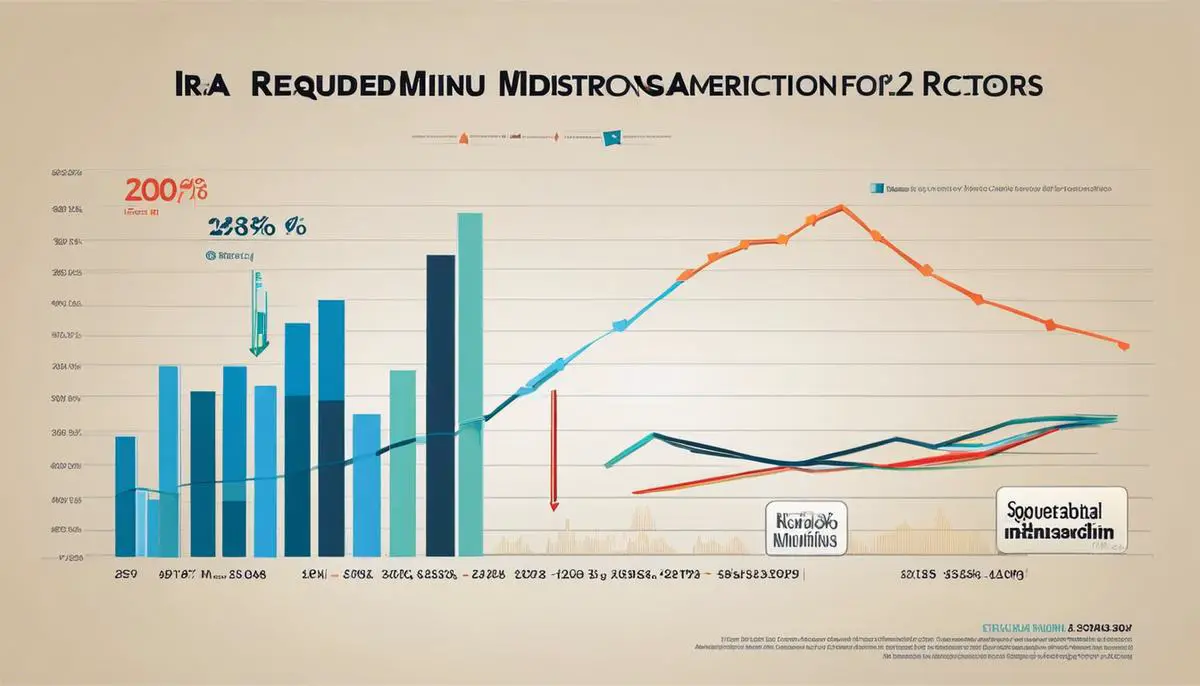Understanding IRA Required Minimum Distributions for 2024
Navigating the intricacies of the Individual Retirement Account (IRA) Required Minimum Distributions (RMDs) can be a challenging process for many individuals who are on the cusp of their retirement years. However, understanding these distributions is crucial due to their significant impact on retirement finances. This overview provides a comprehensive look into the fundamentals of RMDs, delving deep into RMD calculations while highlighting potential changes poised for implementation in the year 2024. Furthermore, the tax implications of these distributions are discussed, providing clarity on how they might affect an individual’s tax landscape. Finally, proven strategies are outlined to mitigate the RMD impacts, offering practical steps tailored to optimize financial management during the retirement phase. The aim is to inform and prepare the general public for a successful journey into their golden years.
The Basics of IRA Required Minimum Distributions
Steering Through the Expected IRA RMD Shifts of 2024
Revamping retirement strategies and navigating potential regulatory changes is key to optimally growing wealth portfolios. For those managing retirement accounts, the discussion of Individual Retirement Account (IRA) Required Minimum Distributions (RMDs) is paramount. Given the dynamic nature of financial markets and legislative rules, we inevitably anticipate shifts in IRA RMD standards come 2024.
Consider this scenario: You have either an inherited or traditional IRA and you’ve reached the point where the government mandates you to withdraw a certain amount each year. That’s your RMD—further indicating that change is always on the horizon in the financial sector.
Now is an opportune time to identify some potentially impactful shifts related to IRA RMDs in 2024. But how can we brace our portfolio for these shifts and leverage them to enhance future growth? Below are two main anticipated changes and proposed strategies to navigate them successfully.
- Possible RMD Age Increase:
- Taxation and RMDs:
The Secure Act of 2019 raised the RMD age from 70 ½ to 72. Lawmakers are considering future legislation that could push this age even further. If enacted, wealth accumulation periods would lengthen, providing more time for your IRA to grow tax-deferred.
Action Plan: Be proactive. Continue contributing and growing your IRA in anticipation of a further delayed RMD age. More importantly, revisit your estate planning strategies to complement this possible change.
We might witness adjustments to taxation on IRA distributions. Given the economic repercussions of the pandemic, the government might seek to recover lost revenue by amending tax rates for RMDs—meaning, a bigger chunk of your distribution might go to Uncle Sam.
Action Plan: A potential increase in tax rates should prompt diversified income planning. Benefits derived from assets like real estate or tax-efficient mutual funds could provide a cushion against high tax on RMDs.
Navigating these potential shifts successfully demands strategic positioning, acute awareness, consistency, and adaptability. Before deploying any of these proposed strategies, seek insightful advice from financial experts who have an in-depth understanding of the forthcoming IRA RMD adjustments in 2024. Remember, in the world of finance, change is not just inevitable—it’s the rule of the game.

Diving Deep into RMD Calculations
“Decoding IRA Required Minimum Distributions for 2024: Calculations and Influential Factors”
Accurately forecasting the rise and intricacies of IRA RMDs for 2024 starts with a basic understanding of the stimuli affecting these metrics. While previous discussions have touched on aspects such as new retirement strategies, upcoming regulatory changes, and the significance of proactive planning, this conversation sharpens its focus on the key levers influencing RMDs in 2024.
The role of Treasury life expectancy tables can’t be overlooked in comprehending RMD calculations. These tables offer estimates on life expectancies used by the IRS to determine RMD amounts. The current pointers hint towards a probable update in these tables for 2024, which implies lower RMDs.
Regulation and governmental policies play another principal role in defining RMDs. Despite an age increase for RMDs having already been implemented, suggestions indicate a further rise in the age limit, contingent on impending legislative changes. This change could be a key factor in smaller RMD amounts and longer deferral periods for taxpayers.
The state of the economy is another variable that strongly influences RMD calculations. Fluctuating market returns represent a risk that could either multiply or diminish the value of contributions over time. It’s important to stress that a constructive approach towards unpredictable market behavior, such as diversification, can minimize these risks.
Taxation on RMDs is a prominent area where potential changes can impact the total distribution. As it stands, there’s speculation around an increase in tax rates for RMDs in 2024. However, maneuvers like the utilization of Qualified Charitable Distributions, currently an exempt element, can bypass potential tax increases.
Lastly, the size of the initial balance of the IRA account will considerably dictate the RMD amount. The larger the balance, the larger the distribution. Investors should take advantage of current lower tax rates to convert their traditional IRA to a Roth IRA leading up to 2024, potentially decreasing future tax burdens.
Undeniably, the many factors that’ll shape the landscape of the IRA RMD in 2024 necessitates dynamism. Sustainable approaches like diversified income planning and relying on expert financial counsel are essential tools for navigation sown in the complexities of IRA RMDs. Keeping in step with these trends and adjustments will allow investors to aptly anticipate and respond to any forthcoming scenarios.
Remember, astute and informed decision-making can be the distinction between financial stagnancy and progressive wealth generation. In the financial world, appropriate preparedness isn’t just a virtue – it’s an absolute necessity.

Impact of IRA RMDs on Your Tax Liability
With continued disruptions in global trading environments and shifts in domestic policies, the financial landscape is rapidly evolving. As such, the call to revisit and refresh individuals’ financial planner guides becomes less of a request and more of an immediate action point for every savvier investor, especially those reaching their golden years. An integral part of these revisions must include a critical exploration of the IRA Required Minimum Distributions (RMDs).
As you may understand, leveraging traditional IRA RMDs as a reliable revenue stream in retirement has always been a smart play. However, as 2024’s proposed changes loom, reducing tax liability is becoming a cornerstone in maintaining a well-adapted retirement strategy.
Preliminary discussions indicate a review of the treasury life expectancy tables might be on the cards for 2024. Currently, these tables play a fundamental role in determining your RMD amounts. If the proposed update to these tables is approved, we could see a resultant decrease in your RMDs. Lower RMDs mean less income, which subsequently limits your tax burdens.
Additionally, debates around further increasing the age limit for RMDs are gaining momentum. This potential demographic shift could allow for more deferral periods, which would reduce your annual RMD amount. Consequently, you might see your tax liabilities shrink.
RMD calculations might also be influenced by fluctuations in the economic climate. Thus, with the uncertainties and risks associated with variable market returns, crafting a responsive and adaptive retirement investment plan is imperative.
The possibility of tax rates on RMDs increasing in 2024 is another intriguing topic of discussion. One plausible path to minimize the impact of such a potential increase is through Qualified Charitable Distributions. By channeling your RMDs toward charity, you sidestep potential tax hikes associated with RMDs and contribute meaningfully to society.
A critical determining factor of your RMD amount remains the initial balance in your IRA account. Therefore, implementing strategies that ensure this balance remains robust is an advantageous move. For instance, exploring the possible conversion of traditional IRAs to Roth IRAs before the turn of 2024 may be a wise choice. This conversion could help reduce future tax burdens, thereby offering an increased sense of financial security in your retirement years.
Keeping tabs on these labyrinthine IRA RMD procedures underscores the need for skilled financial advisement. The complexities of IRA RMD processes are becoming increasingly overwhelming for untrained individuals. Linking with industry experts, who can provide insightful direction and sound advice, could make all the difference in your financial journey.
In conclusion, while the exact changes to the IRA RMD for 2024 are yet to be announced, it is clear that careful and informed decision-making will play a pivotal role in optimizing your financial plan. Preventive and proactive steps today could safeguard your financial flexibilities tomorrow. Therefore, maintaining agility in adapting to these changes is not just desirable but essential in preserving the quality of your retirement. After all, your retirement should be a time of relaxation and enjoyment – not one of financial burden.

Optimal Strategies for Minimizing RMD Impact
Irrespective of these detailed insights and developments around IRA RMDs, one must understand that other creative strategies exist that could offer potential benefits as the landscape shifts drastically before 2024. One such option is to diligently consider in-plan Roth Rollover (IRR), a potent strategy that could prove to be invaluable in the coming years. By adopting IRR, the taxable amounts converted into Roth are taxed in the year of the conversion, which takes effect prior to the increase in the tax rate, and could potentially result in long-term tax savings.
While this could provide a directive path, inbound gifting, another under-scrutinized strategy, is worth considering. With inbound gifting, loved ones in lower tax brackets can be gifted an IRA, which effectively moves the tax liability to a lower bracket. This approach focuses on multi-generational planning and requires the understanding of differing tax brackets within your unique familial structure.
Similarly, the partial annuitization of IRA assets can also play a crucial role in minimizing the potential tax burden of RMDs in 2024. The inclusion of a Qualified Longevity Annuity Contract (QLAC) within one’s retirement planning could ensure a part of the IRA balance is effectively removed from the RMD calculations, reducing the required distributions and thereby offering fiscal resilience.
Furthermore, it’s worth noting that the IRS offers a one-time-only opportunity to miss an RMD without a penalty, known as the “first-time penalty abatement” policy. Astutely planning for this exemption within your strategic roadmap could alleviate impending fiscal pressures posed by the extensive changes anticipated in 2024 regarding IRA RMDs.
By deploying an Intelligent Systematic Withdrawal Plan, one can customize the withdrawal rate based on personal retirement goals, market performance, other income sources, and their spending needs. This can potentially improve the tax efficiency of the financial portfolio and help sustain wealth for a longer span.
Finally, financial professionals within your inner circle must become increasingly diligent in curating diverse investment portfolios. By investing in a blend of taxable, tax-deferred, and tax-free accounts, impacts associated with changes in tax laws can be significantly reduced through effective asset location strategies. This approach, called tax diversification, could provide much-needed flexibility in the response to RMD changes and potential tax increases.
In the midst of regulatory uncertainties and shifting market dynamics, these avant-garde tactics could play an integral role in safer navigation through IRA RMDs in 2024. Arm yourselves with these insights and prepare to make astute decisions that adversaries will wish they’d made first. Prioritize your fiscal health, seek expert advice, and remember—the tide waits for no man. Are you ready to surf the wave?

Understanding IRA required minimum distributions and their implications is a vital component of financial planning when contemplating retirement. The practical knowledge of how RMDs are calculated, together with the upcoming 2024 changes, enables individuals to envisage their financial projection accurately. Being cognizant of the tax liabilities associated with these distributions better situates a retiree for optimal financial health. Equipped with varied strategies to minimize the impact of RMDs, it becomes possible to effectively strategize the timing and manner of withdrawals. Tax mitigation techniques also play an integral part in cushioning against potential financial hiccups. Armed with this wealth of information, individuals can approach their retirement years with confidence and financial peace. The key towards a smooth financial transition into retirement lies in information, planning, and strategic execution.


Leave a Reply